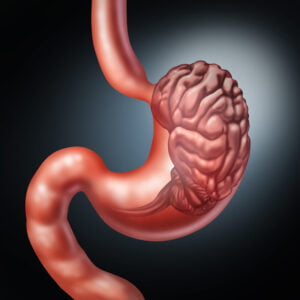The Triune Brain Backstory: Meet Dr MacLean…
Back in the 1960s, American physician and neuroscientist Paul D. MacLean proposed the triune brain as a model of the evolution of the vertebrate forebrain and behavior.1
MacLean claimed our brains consist of three significant structures. (Let’s do the coaches’ hand signals 🙂 
- The reptilian complex (aka brain stem)
- The paleomammalian complex (aka limbic system)
- And the neomammalian complex (aka the prefrontal lobes)
MacLean’s theory stated:
- The structures were sequentially added along the course of the evolution of our species (along w other mammals)
- With the older parts being the brain stem, followed by the limbic system, and the newest being the prefrontal lobes
- All three parts were independently conscious, and with their own specific functions:
- The reptilian part is in charge of our primal instincts
- The limbic system is in charge of our emotions
- And the neocortex: responsible for objective or rational thoughts and executive functions
All Models Are Wrong, Some Are Useful
The useful part:
- The theory has been embraced by some psychiatrists and at least one leading affective neuroscience researcher. 2
- The model especially appeals to psychotherapists because it seemed to give biological credence to Freud’s theory of personality with the id, ego, and superego mapping neatly onto the reptilian, limbic, and cortical brains.3
- Model is used in a large % of college-level textbooks
- Agile coaches love hand gestures….
Non-Academic Stuff
Many authors drew heavily on the triune brain concept in their books bringing these ideas to wider, nonacademic audiences:
- Arthur Koestler made it the centerpiece of much of his work, notably The Ghost in the Machine. (1967)
- Carl Sagan’s (1978) Pulitzer Prize-winning book, The Dragons of Eden,
- English novelist Julian Barnes quotes MacLean in his 1982 novel Before She Met Me.
- Howard Bloom, in his book The Lucifer Principle, (1995) references the concept (of the triune brain) in his explanations of certain aspects of human behavior.
- Peter A. Levine uses the triune brain concept in his 1997 book Waking the Tiger to explain his somatic experiencing approach to healing trauma
- Steven Johnson’s (2005) Mind Wide Open
- 2020 The Advice Trap By Michael Bungay Stanier – Lizard brain makes an appearance. Referencing his 2016 book The Coaching Habit Michael Bungay Stanier asks about four drivers that humans weigh to determine if a situation is safe or not:
- Tribe: “Are you with me, or against me?”
- Expectation: “Do I know what’s about to happen, or not?”
- Rank: “Are you more or less important than me?”
- Autonomy: “Do I have any say in this, or not?”
- All wrapped in references to reptile brain and higher brain functions
Additional Connections
 SCARF
SCARF- David Rock, the author of Your Brain at Work, classified five areas of social experience as it applies to collaborative groups via his SCARF model along with a range of possible valences (+/-) and pre-frontal cortex responses
- Honestly, I’m a bit fuzzy if Rock is connected to MacClean’s work. If you know, ping me. I’d love to learn more…
All Models Are Wrong.
Debunking MacLean’s Triune Brain
In researching the topic, found out that since the 1970s in many circles of evolutionary, comparative, and developmental neuroscience the concept of the triune brain has been subject to criticism.45
Humans are not at the mercy of mythical emotion circuits buried deep in the animalistic parts of our highly evolved brain: we are architects of our own experience. Share on XLet’s dig into some recent literature:
Rethinking the Lizard Brain: Meet Dr. Sara McKay
 Dr. Sara McKay, an Oxford University-educated neuroscientist, director of The Neuroscience Academy, and author of The Women’s Brain Book wrote in 2020:
Dr. Sara McKay, an Oxford University-educated neuroscientist, director of The Neuroscience Academy, and author of The Women’s Brain Book wrote in 2020:
- “The lizard brain: the myth lurking in every coaching conversation.”3
In a wonderfully titled article “Your Brain Is Not an Onion With a Tiny Reptile Inside” – also from 2020 – Joseph Cesario et al noted three major problems with the triune brain model from the perspective of evolution.6
- The Triune Brain Model implies evolution is a linear progression with one organism evolving into the next: lizards > mice > monkeys > humans
- This is wrong! Mammals did not evolve from reptiles. Mammals and reptiles share a common fish-like ancestor.
- “… the correct view of evolution is that animals radiated from common ancestors. Within these radiations, complex nervous systems and sophisticated cognitive abilities evolved independently many times.”7
- Next, the theory is based on the belief that the brain evolved with more complex layers being added on top of pre-existing layers, like geological strata
- Wrong: Evolution consists of transforming existing parts
- Finally, there’s an assumption that the cerebral cortex is unique to mammals
- Wrong again – all vertebrates – reptiles, fish, and birds – have a cerebral cortex (aka forebrain).
 Are you finding value from the content and resources on my website? Show your appreciation by buying me a virtual coffee.
Are you finding value from the content and resources on my website? Show your appreciation by buying me a virtual coffee.In Summary: the Triune Brain Theory is Bunkum, Senseless Talk, Nonsense
- The triune model is oversimplified8 and inaccurate in terms of our brain activity, our emotions, and our behaviors,
- Modern research and imaging capabilities show us that neural structures are NOT tied to specific cognitive functions.9 There is no hard-wired lizard-brain “fear circuit.”
- Due to its longevity, the triune brain idea has also been called “one of the most successful and widespread errors in all of science.”10
Now WTF Do We Do?
If the model is wrong is it okay to still use it? Is it dangerous? Are there alternatives?
Emotions are not Pre-Wired – We Construct Them
While evolution has done quite a bit of heavy lifting, we do possess swift-acting threat-detection circuits. Various other, additional ingredients are processed by a network that builds consciously experienced feelings in the moment11 based on what is going on around us. (Emotion Fingerprints or Emotion Populations? A Meta-Analytic Investigation of Autonomic Features of Emotion Categories)
In an easier-to-read title – 7½ Lessons About the Brain (2021) – Lisa Feldman Barrett shares the ingredients:
- The physiological sensations we feel in our body (See Attitudes and Intentions)
- The situation we’re in
- The people we’re with
- Our memories and personal experiences (See Archeology of Your Patterns)
- The language we’ve learned to describe our conscious feelings12
And Maybe “That Gut” Feeling…

…is more based on science than we realize. There’s a wonderful article that the BBC put out in 2023, “How gut bacteria are controlling your brain” – The article dives into our complex and remarkable biome.13 It turns out, according to this article, that these microbes that call our bodies their home don’t just help to keep our brains in prime working order by freeing up nutrients in our food. But they could also shape our very thoughts and behaviors.14
Feed Your Microbes (Not Your Lizard Brain)
There’s a wonderful TEDx talk that explores how the enteric nervous system goes beyond just processing the food we eat. For example, did you know that the “gut-brain” creates and stores 95% of our serotonin!15
Polyvagal Theory (Stephen Porges 1994)
 There’s another theory that consciousness is distributed in the body, and it doesn’t exist in that three-pound lump of gray matter inside our skulls. It’s called the polyvagal theory.16 The theory states we have autonomous nervous system structures that are deeply involved:
There’s another theory that consciousness is distributed in the body, and it doesn’t exist in that three-pound lump of gray matter inside our skulls. It’s called the polyvagal theory.16 The theory states we have autonomous nervous system structures that are deeply involved:
- Parasympathetic (rest, digest, repair)
- Ventral vagal complex – rest, digest, relax
- Dorsal vagal complex – immobilizaiton, dissociation, freeze
- Sympathetic (fight-flight) – anxious, angry, aggressive, scared
These neural structures are not tied to specific cognitive functions but are impacted by a multitude of things: childhood development, and adult development.
Robert Kegan dives into adult development concepts:17
- Impulsive Mind
- Instrumental Mind
- Socialized Mind
- Self-Authoring Mind
- Self-Transforming Mind (See Unhooking Your Buttons)
This whole range of embodied cognitive neuroscience honestly is way beyond my ken.
If you wanna dive in, see The Embodied Brain: Towards a Radical Embodied Cognitive Neuroscience
Does Any of This Really Matter?
“The most powerful person in the world is the storyteller. The storyteller sets the vision, values and agenda of an entire generation that is to come.” – Steve Jobs
I believe the stories we tell matter. All of us, as individuals, are part of a complex adaptive system that depends on social context. The language and metaphors we use impact our beliefs and our behaviors among our common systems: teams, clans, tribes, or value streams if you’re part of an agile release train.
Some wisdom from another Lisa Feldman book, How Emotions Are Made, (2018):
- “Humans are not at the mercy of mythical emotion circuits buried deep in the animalistic parts of our highly evolved brain: we are architects of our own experience.”18
Instead of using neuro scientifically and evolutionarily incorrect analogies, we need to expand our palate.
Instead of blaming hard wiring or Darwin, maybe we realize that we – not some imaginary reptile inside our skulls – are in charge.
Explore Your Beliefs and Behaviors
Get started on the journey by:
- Maintaining awareness of ourselves, our default behavior patterns, and intentions
- Exploring ways to increase our ability to collaborate, problem-solve, and negotiate
- Learning to build trust, overcome defensiveness, and seek constructive ways of getting things done
Here are some deeper dives:
You May Also Like
 Did this article help you out? Show your appreciation by buying me a virtual coffee. Help fuel more great content!
Did this article help you out? Show your appreciation by buying me a virtual coffee. Help fuel more great content! Read More
References
- https://en.wikipedia.org/wiki/Triune_brain [↩]
- Panksepp, J. (2003). Foreword to Cory, G. and Gardner, R. (2002) The Evolutionary Neuroethology of Paul MacLean: Convergences and Frontiers. ISBN 978-0-275-97219-6[page needed] https://www.amazon.com/Evolutionary-Neuroethology-Paul-MacLean-Convergences/dp/0275972194 [↩]
- https://drsarahmckay.com/rethinking-the-reptilian-brain/ [↩] [↩]
- Cesario, Joseph; Johnson, David J.; Eisthen, Heather L. (8 May 2020). “Your Brain Is Not an Onion With a Tiny Reptile Inside”. Current Directions in Psychological Science. 29 (3): 255–260. doi:10.1177/0963721420917687. S2CID 218960531. https://journals.sagepub.com/doi/10.1177/0963721420917687 [↩]
- Barrett, Lisa Feldman (2020). “You Have One Brain (Not Three)”. Seven and a half lessons about the brain. Boston: Houghton Mifflin Harcourt. pp. 13–28. ISBN 978-0-358-15714-4. OCLC 1129098750. https://www.amazon.com/Seven-Half-Lessons-About-Brain/dp/B085DLCMTY/ [↩]
- Cesario, Joseph Op. Cit. [↩]
- ibid [↩]
- Smith, C.U.M. (15 January 2010). “The Triune Brain in Antiquity: Plato, Aristotle, Erasistratus”. Journal of the History of the Neurosciences. 19 (1): 1–14. doi:10.1080/09647040802601605. PMID 20391097. S2CID 24578071. [↩]
- https://www.ncbi.nlm.nih.gov/pmc/articles/PMC5785564/ Historical Pitfalls and New Directions in the Neuroscience of Emotion (2020) [↩]
- The embodied brain: towards a radical embodied cognitive neuroscience https://www.ncbi.nlm.nih.gov/pmc/articles/PMC4422034/ [↩]
- Emotion Fingerprints or Emotion Populations? A Meta-Analytic Investigation of Autonomic Features of Emotion Categories: https://www.ncbi.nlm.nih.gov/pmc/articles/PMC5876074/pdf/nihms907808.pdf [↩]
- https://lisafeldmanbarrett.com/ – 7 ½ lessons about the brain [↩]
- https://www.bbc.com/future/article/20230120-how-gut-bacteria-are-controlling-your-brain [↩]
- “How gut bacteria are controlling your brain” https://www.bbc.com/future/article/20230120-how-gut-bacteria-are-controlling-your-brain [↩]
- Think Twice: How the Gut’s “Second Brain” Influences Mood and Well-Being https://www.scientificamerican.com/article/gut-second-brain/ [↩]
- The Anatomy of Anxiety: Understanding and Overcoming the Body’s Fear Response (2022) – Ellen Vora p172 [↩]
- https://www.youtube.com/watch?v=BoasM4cCHBc [↩]
- How Emotions Are Made: The Secret Life of the Brain https://www.amazon.com/How-Emotions-Made-Lisa-Barrett/dp/1328915433/ [↩]

 SCARF
SCARF


